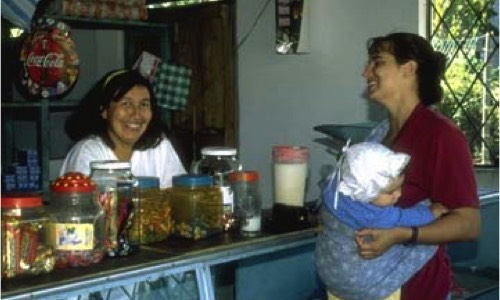Women, Crafts and Conservation Attitudes

The village of Santa Marianita is located in the 14,000 hectare buffer zone area adjacent to La Reserva Maquipucuna, a 5,000 hectare biological reserve with ecotourism facilities owned and managed by Fundación Maquipucuna (FM). While the goals of the Reserve are to protect its forest and wildlife, and to increase its land holdings in order to establish a large corridor of contiguous forest in north-western Ecuador, the goals of people living in communities in these buffer-zone areas are quite different. Three concepts were central to this study: 1) Local conservation attitudes and practices are crucial for long-term success and support of protected areas; 2) Crafts are extremely important to the ecotourism industry -- they enable residents, especially women, to devote spare to full time making an income; and 3) Training in an ecotourism trade is an important way to supply skills to residents. After several years of working with local residents, FM staff voiced concern over hunters in the Reserve, lack of jobs for villagers, and how training of residents could be improved.
Dr. Lash conducted semi-structured interviews over a two-month period with 8 key informants and 31 women in the village of Santa Marianita, to determine possible links between ecotourism training and conservation attitudes of local women. Responses from women in the artisan group, Los Colibrís (LC), were compared to responses from other village women with various training backgrounds. Except for a few service jobs, LC and the Reserve are the only employers of women other than the multitude of sugar cane farmers. Results found that women do exhibit a link between conservation training and positive conservation attitudes and practices, such as re-planting tagua palm trees for use in craftmaking. Active communication between Reserve owners and local residents, particularly women, is key to the symbiotic progress of both the Reserve and village. This project was part of the research for Dr. Lash's Doctoral dissertation in Forest Resources at the University of Georgia.
Dr. Lash conducted semi-structured interviews over a two-month period with 8 key informants and 31 women in the village of Santa Marianita, to determine possible links between ecotourism training and conservation attitudes of local women. Responses from women in the artisan group, Los Colibrís (LC), were compared to responses from other village women with various training backgrounds. Except for a few service jobs, LC and the Reserve are the only employers of women other than the multitude of sugar cane farmers. Results found that women do exhibit a link between conservation training and positive conservation attitudes and practices, such as re-planting tagua palm trees for use in craftmaking. Active communication between Reserve owners and local residents, particularly women, is key to the symbiotic progress of both the Reserve and village. This project was part of the research for Dr. Lash's Doctoral dissertation in Forest Resources at the University of Georgia.